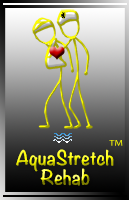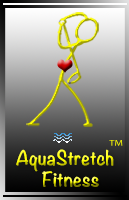AquaStretch™ Basics+
Welcome to AquaStretch™ Basics+ Training. We are dedicated to provide a hands-on learning experience for an in-depth appreciation and comprehensive approach to AquaStretch™.
A special thank you to George Eversaul who has blessed us with the knowledge, performance and creativity of AquaStretch™.
Let the healing begin...
AquaStretch™ Theory & Concepts
 Patient Education -
Patient Education -
This technique is based on the belief that your body knows how to fix itself better than you or I may know how. I will be taking you through a series of different positions in which we are going to stretch. Once we are in the starting position, I will apply a little pressure/stretch to an area of your body and then I will ask you to "move, if you feel the need to move." At that time, I want you to feel free to move your body to stretch in all different ways. I am here to assist and provide additional pressure (accentuation) to help dissolve the adhesions that are causing you pain and discomfort.
There is "good pain" and "bad pain". Do you know the difference?
 "Good pain" is ok. "Bad pain" is not ok. If you experience any "bad pain" at all, I want you to tell me to stop - immediately!
"Good pain" is ok. "Bad pain" is not ok. If you experience any "bad pain" at all, I want you to tell me to stop - immediately!
 REMEMBER - NO BAD PAIN!!!
REMEMBER - NO BAD PAIN!!! 
 Four Basic Step Procedure -
Four Basic Step Procedure -
 1. Play
1. Play
 2. Freeze
2. Freeze
 3. Pressure
3. Pressure
 4. Move... if you feel the need to move
4. Move... if you feel the need to move
During "Play", the patient is encouraged to randomly move part of their body (i.e., leg or arm) and to "freeze" in the position their body experiences pain or restriction. While the patient maintains their "frozen" position, the patient verbally (not pointing with their finger), directs the therapist to the anatomical location where the patient feels the pain or restriction. (The therapist observes the patient's motion just prior to the "freeze point" to determine their vector of movement) Then, the therapist places "pressure" with their appropriate digit (finger/thumb) in the exact location the patient indicates pain or restriction and is asked to "Move, if they feel the need to move". The therapist continues to stretch the patient's body in the same vector of motion observed just prior to "freezing".
 Fascial Adhesion Cycle -
Fascial Adhesion Cycle -
Fasciae are connective tissue found throughout the entire body. Fasciae encompass and hold muscles, nerves and blood vessels tightly together. According to the Fascial Adhesion Theory, excessively micro-calcified adhesions may form within the fasciae. These adhesions develop as a normal response to an injury. They may excessively calcify if the injured area is used prematurely. These adhesions may also excessively calcify following intense training workouts or in response to occupational aggravations. (ie. food servers, hairstylists) Fascial adhesions are essentially internal band-aids that form around the injury to protect it while it heals. The formation of fascial adhesions causes a person to compensate and move out of their normal range of motion. The longer the body compensates, the harder the adhesions become. This may also lead to layers of fascial adhesions around the injury, and layers of fascial adhesions throughout the rest of the body due to compensated movement patterns. If left untreated, may contribute to neurological and vascular entrapments/impairments.
 Precautions/Contraindications -
Precautions/Contraindications -
• No Breaks (Fractures)
• No Tears
• Joint laxity
• Post-op considerations
• Joint Replacements
• Osteoporosis
• Anticoagulant medications (possible bruising)
• Long-term steroid use
• Edema of unknown cause (medical clearance recommended)
• Active cancer, current or past radiation (at least over the area)
• Heavy meds or substance abuse
• Litigation cases (in wellness/fitness situations)
• Non responsive first treatment (i.e., hydrophobic)
 Red Flags -
Red Flags -
• Fracture
• Infection
• Cauda Equinae
• Aortic Aneurysm
• Cancer
 BASIC Starting Positions & Grips -
BASIC Starting Positions & Grips -
 "Wall Hang": WH; Foot/ankle work including Foot Grip (FG), Ankle Grip (AG) & Toe Grip (TG)
"Wall Hang": WH; Foot/ankle work including Foot Grip (FG), Ankle Grip (AG) & Toe Grip (TG)
 "IT Pump": ITP; Fascial release to the Iliotibial band.
"IT Pump": ITP; Fascial release to the Iliotibial band.
 "Hip Rock": H/Rock; Works to release adhesions during anterior/posterior movement. of the lumbar spine.
"Hip Rock": H/Rock; Works to release adhesions during anterior/posterior movement. of the lumbar spine.
 "Hip Roll": H/Roll; Fascial release for the lumbar, sacrum, and iliac crest regions.
"Hip Roll": H/Roll; Fascial release for the lumbar, sacrum, and iliac crest regions.
 "One Leg Standing": OLS; Fascial release for the hip, knee, and lower back.
"One Leg Standing": OLS; Fascial release for the hip, knee, and lower back.
• Hip Fulcrum: Pressure applied to posterior hip/QL during OLS; works to release adhesions in the SI joint.
 "Two Heavy Feet" THF; (with five variations):
"Two Heavy Feet" THF; (with five variations):
• Lean Back (LB); Cervical adhesion release
• Arch Forward (AF); Cervical anterior adhesion release with cervical extension
• Back to Wall (BTW); knee pressure applied to release adhesions in fascia along the spine.
• Hands/Lean on Wall (Cops); Fascial release for the Sacro-iliac, lower back, and neck.
• Shoulder Roll; works to release adhesions in the clavicle and scapula.
• Wrist/Elbow work; releases adhesion for the carpal tunnel and elbow.
 "Head Hang": (HH); Fascial release for the neck and capitus muscles.
"Head Hang": (HH); Fascial release for the neck and capitus muscles.
 Aquastretch™: Ride The New Tidal Wave In Aquatic Therapy
Aquastretch™: Ride The New Tidal Wave In Aquatic Therapy
 AquaStretch™ ATRI Certificate Manual 2011
AquaStretch™ ATRI Certificate Manual 2011








Copyright © 2012-2020 All Rights Reserved
 "Good pain" is ok. "Bad pain" is not ok. If you experience any "bad pain" at all, I want you to tell me to stop - immediately!
"Good pain" is ok. "Bad pain" is not ok. If you experience any "bad pain" at all, I want you to tell me to stop - immediately!




